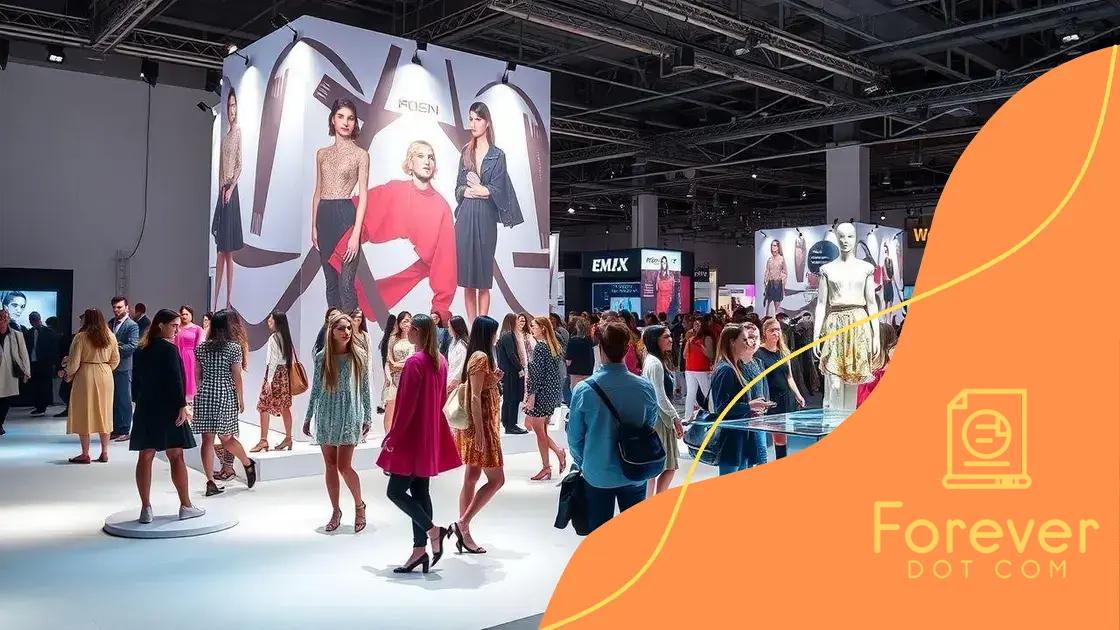The rise of immersive fashion exhibitions: a new trend

The rise of immersive fashion exhibitions leverages technology and creativity to engage audiences, foster connections, and promote sustainability, transforming how fashion is experienced and understood.
The rise of immersive fashion exhibitions is reshaping the landscape of fashion experiences. Have you ever wondered how these exhibitions engage audiences differently? Let’s dive into this exciting trend.
What are immersive fashion exhibitions?
Immersive fashion exhibitions are redefining how we engage with fashion. These events allow visitors to experience fashion artfully and interactively. By combining technology with creativity, they captivate audiences in a way traditional exhibitions often cannot. Are you curious about what makes these exhibitions so unique?
Understanding Immersive Fashion Exhibitions
At their core, immersive fashion exhibitions blend various forms of art, technology, and style. This fusion enables organizations to create environments where visitors feel like they are part of the show, rather than simply observers. This approach encourages a deeper connection with fashion, allowing attendees to experience the emotional and cultural context behind each piece.
Features of Immersive Fashion Exhibitions
- Interactive Installations: Exhibits often include touch screens or VR experiences that allow guests to engage with the fashion pieces.
- Dynamic Spaces: The layout and design change continuously, making each visit a new adventure.
- Multisensory Experiences: Sound, smell, and visual storytelling come together to create a unique atmosphere.
- Designer Collaborations: Often, exhibitions feature collaborations between designers and artists to push the boundaries of fashion.
The combination of these elements creates a captivating experience that resonates with visitors. Rather than just displaying clothes on mannequins, immersive fashion exhibitions invite the audience to enter the world of the designer. This allows for storytelling that can evoke personal connections and emotional responses.
As we explore further, consider how these exhibitions might evolve with advancements in technology. The integration of augmented reality (AR) and virtual reality (VR) will play a crucial role in how we experience fashion in the future. Envision a scenario where visitors can try on outfits virtually, or interact with the fashion story in real-time!
Ultimately, the growth of immersive fashion exhibitions reflects changing consumer expectations in the fashion industry. As audiences seek more meaningful experiences, brands must adapt and innovate in ways that resonate deeply with their customers’ desires.
Key benefits of immersive experiences in fashion
Immersive experiences in fashion bring numerous benefits that are reshaping the industry. These experiences captivate audiences and create lasting impressions. For brands, recognizing the advantages of these exhibitions is vital for connecting with consumers and staying relevant.
Enhanced Engagement
One of the primary benefits is enhanced engagement. Immersive exhibitions attract visitors by involving them in unique stories and environments. Guests don’t just observe; they participate, making their experience more memorable. When people feel like they are part of the narrative, they are more likely to share their experiences on social media, increasing visibility for the brand.
Building Stronger Connections
Fashion is not only about clothes; it’s about emotions and identity. Immersive experiences deepen connections between brands and their audience by evoking feelings through art and design. When visitors connect on an emotional level, it leads to stronger loyalty. They see the brand in a new light, which can influence their purchasing decisions.
- Storytelling: Brands can tell their stories in compelling ways that resonate with their audience.
- Personalization: Visitors often have opportunities to customize their experiences, making it more relevant to them.
- Increased Brand Awareness: Engaging experiences encourage word-of-mouth marketing.
- Innovation: These experiences push brands to think outside the box, leading to creative solutions.
Moreover, immersive experiences often harness the latest technologies, making the visit intriguing. For example, augmented reality displays can showcase how fashion pieces look on different body types, allowing guests to virtually try on outfits. This innovation transforms the way customers shop, offering a preview before making a purchase.
Furthermore, these exhibitions can attract a wider audience. People from diverse backgrounds may find value in participating. By showcasing various cultures and styles, brands can highlight their commitment to inclusivity, widening their consumer base.
Overall, embracing immersive experiences is not just a trend but a strategic move for brands looking to innovate and connect meaningfully. These experiences set the stage for the future of fashion, merging technology with the artistry of fashion in compelling ways.
How brands are embracing this trend

Brands are increasingly seeing the value in immersive fashion exhibitions as a way to connect with their audience and showcase their creativity. By embracing this trend, companies can enhance their visibility and engage consumers in new and exciting ways.
Innovative Collaborations
Many fashion brands are forming partnerships with artists and technologists. This collaboration leads to unique experiences that blend fashion with art. By doing so, they create spaces that invite interaction and exploration. These partnerships enrich the narrative around their collections, making the exhibitions a true celebration of creativity.
Utilizing Technology
Advanced technologies, such as virtual reality (VR) and augmented reality (AR), are being utilized to enhance the visitor experience. These tools allow guests to interact with the fashion in dynamic ways. For instance, shoppers can visualize how outfits would look on them without trying them on physically. This tech integration makes the experience more convenient and exciting.
- 360-Degree Views: Offering rotating views of garments maintains visitor interest.
- Interactive Try-Ons: Virtual fitting rooms let guests see potential looks.
- Behind-the-Scenes Access: Brands can share their design processes in real-time.
- Social Media Integration: Visitors can easily share their experiences online, amplifying brand reach.
Brands are also choosing unique locations for these exhibitions. From art galleries to pop-up spaces in city centers, venues play a significant role in creating an immersive atmosphere. Providing a distinct setting reinforces the brand’s identity and makes the experience memorable for visitors. Think about the difference between a typical showroom and an artistically transformed space filled with interactive displays!
Moreover, storytelling has become a crucial aspect of these exhibitions. Brands are crafting narratives around their collections, allowing visitors to experience the story behind each piece. This storytelling approach draws people in, making them feel connected to the designs on a more personal level. As a result, consumers leave with a better understanding of the brand and what it stands for.
Ultimately, by engaging in immersive fashion exhibitions, brands can position themselves as innovators in a highly competitive market. These experiences elevate the fashion journey for consumers, transforming how they perceive and interact with fashion.
The technology behind immersive fashion exhibitions
The technology behind immersive fashion exhibitions plays a crucial role in transforming how we experience fashion. By leveraging innovative tools, brands can create environments that captivate and engage audiences in meaningful ways. Understanding these technologies gives insight into why these exhibitions are so effective.
Virtual Reality (VR) Experiences
Virtual reality has revolutionized the way people interact with fashion. Using VR headsets, visitors can step into a fully immersive environment where they can explore collections as if they were part of a fashion show. This technology creates a sense of presence, allowing guests to appreciate the intricacies of each design in an engaging way.
Augmented Reality (AR) Implementations
Augmented reality enhances the physical space of an exhibition. Through smartphones or AR glasses, guests can see additional layers of information superimposed on the real world. For instance, when they point their device at a garment, they might receive details about the designer, fabric, and the story behind each piece. This interactive layer makes the experience richer and more informative.
- Interactive Displays: Touchscreens and motion sensors enable visitors to engage directly with fashion pieces, making the experience dynamic.
- Projection Mapping: This technology transforms ordinary surfaces into interactive displays that bring stories to life, adding depth to the exhibition.
- Sensors and Analytics: These tools track visitor interactions, providing brands with data that helps them understand preferences and improve future exhibitions.
Furthermore, sound design is essential in creating an immersive environment. Well-curated playlists and soundscapes enhance the overall experience, setting the tone and mood for each exhibition. Imagine walking through collections while surrounded by ambient sounds that reflect the themes of the fashion on display.
Brands are also utilizing 3D modeling technology to create lifelike replicas of their collections. This allows visitors to explore designs from various angles without physical garments being present. Such technology reduces logistical challenges for brands while still offering dynamic presentations.
Ultimately, the integration of advanced technologies within immersive fashion exhibitions not only makes them more engaging but also serves to create a unique bridge between audience and brand. As technology continues to evolve, so too will the possibilities for creating unforgettable fashion experiences.
Future trends in immersive fashion exhibitions
The landscape of immersive fashion exhibitions is constantly evolving. As technology advances and consumer preferences shift, future trends will shape how fashion is experienced. Understanding these trends can help brands stay relevant and engaging.
Personalization at Its Core
One key trend is the rise of personalization. Future exhibitions will likely utilize data to create tailored experiences for visitors. Imagine entering an exhibition where every interaction is customized based on your past preferences and behaviors. This personal touch will make each visit unique and memorable, as brands cater to individual tastes.
Sustainability and Ethical Fashion
Another important trend is the focus on sustainability. As consumers become more environmentally conscious, brands will need to showcase their commitment to ethical practices. Future exhibitions will likely highlight sustainable materials and ethical production processes. By educating visitors on these topics, brands can connect with a more socially aware audience.
- Eco-friendly Installations: Exhibitions will feature materials that are sustainable, reducing environmental impact.
- Renewable Energy Use: Future venues may incorporate renewable energy to power the exhibitions.
- Transparency: Brands will provide behind-the-scenes insights into their supply chains.
- Community Engagement: More brands will involve local communities in their exhibitions, emphasizing social connections.
In addition, technology will continue to play a major role in shaping these experiences. We can expect more widespread use of augmented reality and artificial intelligence in exhibitions. For example, AI could help predict fashion trends based on social media data, allowing brands to adapt their showcases in real-time. Imagine walking into an exhibition where the fashion on display is constantly evolving based on consumer reactions!
Moreover, virtual and hybrid events will become increasingly popular. These formats allow brands to reach wider audiences beyond geographical limitations. Virtual exhibitions can engage participants through interactive experiences from the comfort of their homes, which opens up the possibility for global participation.
As the fashion industry anticipates shifts in consumer behavior, embracing innovation will be key. The merging of technology and fashion is an exciting frontier that holds great promise. Future trends in immersive fashion exhibitions will not only enhance visitor experiences but also redefine how brands communicate their stories.
FAQ – Frequently Asked Questions about Immersive Fashion Exhibitions
What are immersive fashion exhibitions?
Immersive fashion exhibitions are interactive events where visitors engage with fashion through technology, art, and storytelling, creating a unique experience.
How do technology and fashion work together in these exhibitions?
Technology, like virtual reality and augmented reality, enhances the experience by allowing visitors to interact with fashion pieces in innovative and engaging ways.
Why is sustainability important in immersive fashion exhibitions?
Sustainability is crucial as it reflects consumer values and encourages brands to showcase eco-friendly practices and materials, promoting environmental awareness.
How can brands benefit from participating in immersive fashion exhibitions?
Brands benefit by enhancing customer engagement, increasing brand awareness, and fostering deeper connections with consumers through unique and memorable experiences.






